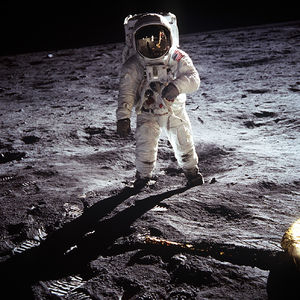CZ:Featured article/Current: Difference between revisions
imported>Chunbum Park No edit summary |
imported>Chunbum Park mNo edit summary |
||
| Line 9: | Line 9: | ||
Despite the many successes, there were two major failures, the first of which resulted in the deaths of three astronauts, Virgil "Gus" Grissom, Ed White and Roger Chaffee, in the Apollo 1 launchpad fire. The second was an explosion on Apollo 13, in whose aftermath the deaths of three more astronauts were averted by the efforts of flight controllers, project engineers, and backup crew members. | Despite the many successes, there were two major failures, the first of which resulted in the deaths of three astronauts, Virgil "Gus" Grissom, Ed White and Roger Chaffee, in the Apollo 1 launchpad fire. The second was an explosion on Apollo 13, in whose aftermath the deaths of three more astronauts were averted by the efforts of flight controllers, project engineers, and backup crew members. | ||
The Apollo program was named after the | The Apollo program was named after the Greek god of the Sun. | ||
==Background== | ==Background== | ||
The Apollo program was originally conceived early in 1960, during the administration of U.S. President | The Apollo program was originally conceived early in 1960, during the administration of U.S. President Eisenhower, as a follow-up to America's Mercury program. While the Mercury capsule could only support one astronaut on a limited Earth orbital mission, the Apollo spacecraft was intended to be able to carry three astronauts on a circumlunar flight and perhaps even on a lunar landing. The program was named after the Greek god of the Sun by NASA manager Abe Silverstein, who later said that "I was naming the spacecraft like I'd name my baby." While NASA went ahead with planning for Apollo, funding for the program was far from certain, particularly given Eisenhower's equivocal attitude to manned spaceflight. | ||
[[Apollo program|...]] | [[Apollo program|...]] | ||
Revision as of 09:06, 26 June 2011

The first manned landing on the moon was successfully accomplished by the Apollo 11 mission on July 20, 1969. Astronaut Neil Armstrong took this photograph of fellow astronaut Edwin ("Buzz") Aldrin walking on the Moon's surface during lunar landing.
The Apollo program was a series of human spaceflight missions undertaken by the United States, during the years 1961–1974, using the Apollo spacecraft and Saturn space launch vehicle. It was conducted by the National Aeronautics and Space Administration (NASA) and was devoted to the goal, expressed in a 1961 address to the U.S. Congress by U.S. President John F. Kennedy, of "... landing a man on the Moon and returning him safely to the Earth ..." within the decade of the 1960s. That goal was successfully achieved by the Apollo 11 mission in July 1969.
The program continued until 1975 with five subsequent Apollo missions which also landed astronauts on the Moon, the last in December 1972. In the six successful Apollo spaceflights, twelve men walked on the Moon. As of 2011, these are the only times that humans have landed on another celestial body.
Equipment that was originally produced for the Apollo program was used for the later Skylab program during 1973–1974 and the joint U.S.−Soviet mission (Apollo−Soyuz Test Project) in 1975. Therefore, those subsequent programs are thus often considered to be part of the Apollo program.
Despite the many successes, there were two major failures, the first of which resulted in the deaths of three astronauts, Virgil "Gus" Grissom, Ed White and Roger Chaffee, in the Apollo 1 launchpad fire. The second was an explosion on Apollo 13, in whose aftermath the deaths of three more astronauts were averted by the efforts of flight controllers, project engineers, and backup crew members.
The Apollo program was named after the Greek god of the Sun.
Background
The Apollo program was originally conceived early in 1960, during the administration of U.S. President Eisenhower, as a follow-up to America's Mercury program. While the Mercury capsule could only support one astronaut on a limited Earth orbital mission, the Apollo spacecraft was intended to be able to carry three astronauts on a circumlunar flight and perhaps even on a lunar landing. The program was named after the Greek god of the Sun by NASA manager Abe Silverstein, who later said that "I was naming the spacecraft like I'd name my baby." While NASA went ahead with planning for Apollo, funding for the program was far from certain, particularly given Eisenhower's equivocal attitude to manned spaceflight.